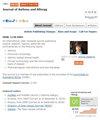哮喘患者吸入短效抗心律失常药和(或)β-2-兴奋剂后,通过肺活量和脉冲振荡计测量支气管扩张剂的反应性
IF 3.7
3区 医学
Q2 ALLERGY
引用次数: 0
摘要
背景:哮喘的支气管扩张剂反应性(BDR)涉及中枢和外周气道,但主要通过β-2-激动剂缓解,并通过肺活量测定进行评估。迄今为止,抗心律失常药可作为缓解药物用于较严重的哮喘。我们假设,将短效β-2 受体激动剂(SABA)和短效毒蕈碱拮抗剂(SAMA)结合使用,也能改善轻中度哮喘患者的反应性。因此,我们旨在比较单独吸入 SABA、单独吸入 SAMA 或同时吸入 SABA 和 SAMA 对哮喘患者中枢和外周气道的直接影响:23名轻中度BDR哮喘患者在三次不同的就诊中分别在吸入SABA(沙丁胺醇)、SAMA(异丙托溴铵)或同时吸入SABA和SAMA前(基线)和吸入后一小时内的多个时间点进行了动态肺活量测定和脉冲振荡测定:结果:与单独使用 SABA 相比,单独使用 SAMA 没有任何改善。然而,吸入 SABA+SAMA 在 FEV1、MMEF、FVC、R5、R20 和 R5-R20 方面的平均 BDR 与单用 SABA 相似或更好。吸入 SABA+SAMA 可使更多患者在 0-10 分钟内达到稳定的 BDR,而且达到 FEV1 (Δ%)> 的速度(3.5 分钟)比单独吸入 SABA(5.1 分钟)快 12%。在 FEV1(p = 0.015)、MMEF(p = 0.0059)和 R20(p = 0.0049)方面,吸入 SABA+SAMA 明显优于单独吸入 SAMA。使用这三个变量突出显示了一个亚组(30%,包括更多男性)患者对吸入 SABA+SAMA 比单独吸入 SABA 更敏感:总的来说,与单独使用 SABA 或单独使用 SAMA 相比,将 SAMA 与 SABA 结合使用能更快且更稳定地提高肺功能。因此,应考虑将 SAMA 作为轻中度哮喘 BDR 患者的附加缓解药物。本文章由计算机程序翻译,如有差异,请以英文原文为准。
Bronchodilator Responsiveness Measured by Spirometry and Impulse Oscillometry in Patients with Asthma After Short Acting Antimuscarinic and/or Beta-2-Agonists Inhalation
Background: Bronchodilator responsiveness (BDR) in asthma involves both the central and peripheral airways but is primarily relieved with beta-2-agonists and evaluated by spirometry. To date, antimuscarinics can be added as a reliever medication in more severe asthma. We hypothesize that combining both short-acting beta-2 agonist (SABA) and short-acting muscarinic antagonist (SAMA) could also improve the responsiveness in mild-moderate asthma. Therefore, we aimed to compare the direct effects of inhaling SABA alone, SAMA alone or combining both SABA and SAMA on the central and peripheral airways in asthma.
Methods: Twenty-three patients with mild-moderate BDR in asthma performed dynamic spirometry and impulse oscillometry before (baseline) and multiple timepoints within an hour after inhalation of SABA (salbutamol), SAMA (ipratropium bromide), or both SABA and SAMA at three different visits.
Results: The use of SAMA alone did not show any improvement compared to the use of SABA alone. Inhalation of SABA+SAMA, however, averaged either similar or better BDR than SABA alone in FEV1, MMEF, FVC, R5, R20 and R5-R20. Inhaling SABA+SAMA reached a stable BDR in more patients within 0– 10 minutes and also reached the FEV1 (Δ%)> 12% faster (3.5 minutes) than inhaling SABA alone (5.1 minutes). Inhaling SABA+SAMA was significantly better than SAMA alone in FEV1 (p = 0.015), MMEF (p = 0.0059) and R20 (p = 0.0049). Using these three variables highlighted a subgroup (30%, including more males) of patients that were more responsive to inhaling SABA+SAMA than SABA alone.
Conclusion: Overall, combining SAMA with SABA was faster and more consistent at increasing the lung function than SABA alone or SAMA alone, and the additive effect was best captured by incorporating peripheral-related variables. Therefore, SAMA should be considered as an add-on reliever for mild-moderate patients with BDR in asthma.
Methods: Twenty-three patients with mild-moderate BDR in asthma performed dynamic spirometry and impulse oscillometry before (baseline) and multiple timepoints within an hour after inhalation of SABA (salbutamol), SAMA (ipratropium bromide), or both SABA and SAMA at three different visits.
Results: The use of SAMA alone did not show any improvement compared to the use of SABA alone. Inhalation of SABA+SAMA, however, averaged either similar or better BDR than SABA alone in FEV1, MMEF, FVC, R5, R20 and R5-R20. Inhaling SABA+SAMA reached a stable BDR in more patients within 0– 10 minutes and also reached the FEV1 (Δ%)> 12% faster (3.5 minutes) than inhaling SABA alone (5.1 minutes). Inhaling SABA+SAMA was significantly better than SAMA alone in FEV1 (p = 0.015), MMEF (p = 0.0059) and R20 (p = 0.0049). Using these three variables highlighted a subgroup (30%, including more males) of patients that were more responsive to inhaling SABA+SAMA than SABA alone.
Conclusion: Overall, combining SAMA with SABA was faster and more consistent at increasing the lung function than SABA alone or SAMA alone, and the additive effect was best captured by incorporating peripheral-related variables. Therefore, SAMA should be considered as an add-on reliever for mild-moderate patients with BDR in asthma.
求助全文
通过发布文献求助,成功后即可免费获取论文全文。
去求助
来源期刊

Journal of Asthma and Allergy
Medicine-Immunology and Allergy
CiteScore
5.30
自引率
6.20%
发文量
185
审稿时长
16 weeks
期刊介绍:
An international, peer-reviewed journal publishing original research, reports, editorials and commentaries on the following topics: Asthma; Pulmonary physiology; Asthma related clinical health; Clinical immunology and the immunological basis of disease; Pharmacological interventions and new therapies.
Although the main focus of the journal will be to publish research and clinical results in humans, preclinical, animal and in vitro studies will be published where they shed light on disease processes and potential new therapies.
 求助内容:
求助内容: 应助结果提醒方式:
应助结果提醒方式:


